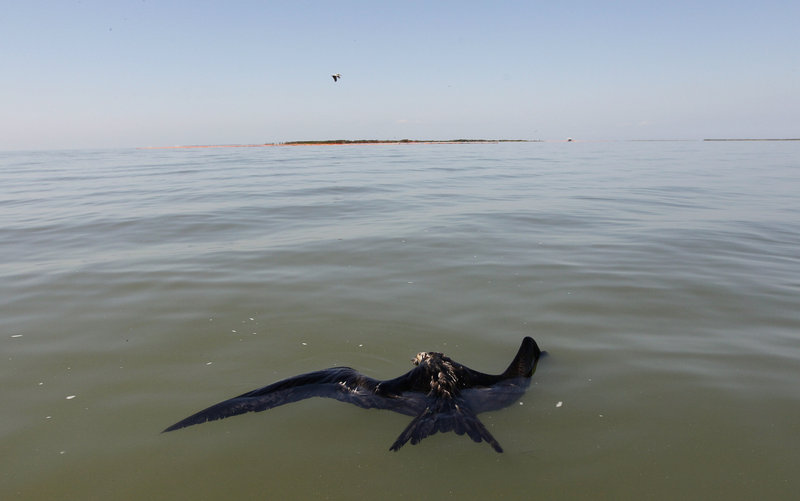The urgent question in the polluted Gulf of Mexico: How bad will this get?
No one knows, but with each day, as the leaking oil well a mile deep remains uncapped, industry observers and scientists are crafting scenarios that range from bad to worse to worst, with some forecasting a calamity of historic proportions.
Several scientists have said in interviews that they believe that the “loop current” of the gulf, a powerful conveyor belt that extends some 3,000 feet deep, will almost surely take the oil down the left flank of Florida to the delicate coral reefs of the Keys. From the Florida Straits, the narrow passage between the Keys and Cuba, the oil could flow into the Gulf Stream, from which it could slather the beaches up the East Coast, they say.
“I think it is inevitable at this stage because we’re seeing it creep slowly toward the loop current,” said University of Miami oceanographer Nick Shay. “If this thing keeps going for two to three months, it’ll be catastrophic.”
But there are many unknowns, and the oil slick itself has been elusive and enigmatic, lurking offshore in the gulf for many days as if choosing its moment of attack. The slick is still to the north of the loop current, Shay said. In rough, churning seas, the visible slick at the surface has shrunk in recent days.
The oil by its nature is hard to peg: It’s not a single, coherent blob, but rather an irregular, amoeba-shaped expanse that in some places forms a thin sheen on the water and in other locations is braided and stretched into tendrils of thick, orange-brown gunk.
A BP executive said Monday that the company is treating the oil at the gulf bottom with dispersant chemicals sprayed from a wand on a robotic submarine. Oil can vary from one well to another, and oil from very deep wells can be thicker and heavier than that from shallow wells.
No one is sure how much oil is leaking. The Coast Guard initially said there was no leak, then said there was a leak of 1,000 barrels a day, then upped the estimate to 5,000 barrels. Adm. Thad Allen, the leader of the federal response and commandant of the Coast Guard, warned against putting too much credence in any estimate.
Ian MacDonald, a professor of oceanography at Florida State University, has calculated the amount of oil based on satellite imagery and established models of oil dispersion and believes that the quantity is already greater than that dumped in Alaska by the Exxon Valdez in 1989. He estimated last week that 9 million gallons of oil are already in the water, compared with 10.8 million gallons in the Valdez disaster.
But he acknowledged that the real amount could be different. In any case, he said, the comparison to the Valdez spill is misguided, because the coastal gulf is far more economically significant than the sparsely populated coast of Alaska.
Despite his bleak estimate of the spill, MacDonald said the rough weather has been a blessing. In heavy surf, the oil has been breaking up, and toxic volatiles in the oil have been evaporating.
“What remains forms what’s called mousse, which is like chocolate mousse. It’s an emulsion, which is an emulsion of oil, air and water, in a thick, gelatinous layer, and that’s nasty stuff,” he said.
The crisis began April 20 with a tragic explosion and fire on the Deepwater Horizon, a huge rig owned by Transocean and leased by BP. Eleven workers died. The rig, insured for $560 million, sank two days later; the riser, the pipe leading to the rig, collapsed. Three leaks have developed, the largest at the end of the drill pipe that extends from the riser.
Robotic submarines have tried to activate a structure called a blowout preventer that sits atop the wellhead and has multiple tools for clamping the flow of oil in an emergency. Efforts have failed.
“It’s really, really devastating,” said Greg McCormack, director of the Petroleum Extension Service at the University of Texas. “On the political front, are we going to be allowed to drill in the deep water again? That’s going to be more devastating to society than to the industry. We’re going to have much higher oil prices because of that.”
Few people are more apocalyptic than Matt Simmons, retired chairman of the energy investment banking firm Simmons & Company International, and a veteran of 41 years in the industry. Simmons, who will speak at the Offshore Technology Conference in Houston this week, has been famous in recent years for warning that the industry is running out of oil. Now he sees a disaster on an epic scale as the pressurized subterranean reservoir known as the Macondo field, estimated to hold 50 million barrels of oil, continues to vent into the gulf.
“It really is a catastrophe,” Simmons said. “I don’t think they’re going to be able to put the leak out until the reservoir depletes. It’s just too technically challenging.”
He said BP’s cleanup costs could mean financial ruin for the company.
“They’re going to have to clean up the Gulf of Mexico,” he said.
Copy the Story Link
Send questions/comments to the editors.



Success. Please wait for the page to reload. If the page does not reload within 5 seconds, please refresh the page.
Enter your email and password to access comments.
Hi, to comment on stories you must . This profile is in addition to your subscription and website login.
Already have a commenting profile? .
Invalid username/password.
Please check your email to confirm and complete your registration.
Only subscribers are eligible to post comments. Please subscribe or login first for digital access. Here’s why.
Use the form below to reset your password. When you've submitted your account email, we will send an email with a reset code.